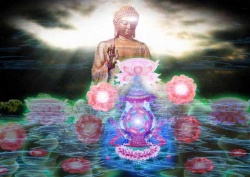Difference between revisions of "Mahâsanghika"
| Line 1: | Line 1: | ||
[[File:1fdh.JPG|thumb|250px|]] | [[File:1fdh.JPG|thumb|250px|]] | ||
| + | |||
| + | |||
| + | |||
| + | |||
| + | |||
| + | |||
| + | |||
[[Mahāsaṅghika]], (from [[Sanskrit]] [[mahāsaṅgha]], “[[great order of monks]]”), [[early Buddhist school in India that]], in its [[views]] of the [[nature]] of the [[Buddha]], was a precursor of the [[Mahāyāna tradition]]. | [[Mahāsaṅghika]], (from [[Sanskrit]] [[mahāsaṅgha]], “[[great order of monks]]”), [[early Buddhist school in India that]], in its [[views]] of the [[nature]] of the [[Buddha]], was a precursor of the [[Mahāyāna tradition]]. | ||
| − | Its [[emergence]] about a century after the [[death]] of the [[Buddha]] (483 bc) represented the first major [[schism]] in the [[Buddhist]] {{Wiki|community}}. Although [[traditional]] accounts of the [[second council]], at [[Vaiśālī]] (now in [[Wikipedia:Bihar|Bihār]] state), attribute the split to a dispute over [[monastic rules]] (see [[Buddhist council]]), later texts {{Wiki|emphasize}} differences between the [[Mahāsaṅghikas]] and the original [[Theravādins]] (“[[followers of the Way of the Elders]]”) regarding the [[nature]] of the [[Buddha]] and of [[arhatship]] ([[sainthood]]). The [[Mahāsaṅghikas]] believed in a plurality of [[buddhas]] who are [[supramundane]] ([[lokottara]]) and held that what passed for [[Gautama Buddha]] in his [[earthly]] [[existence]] was only an apparition. | + | Its [[emergence]] about a century after the [[death]] of the [[Buddha]] (483 bc) represented the first major [[schism]] in the [[Buddhist]] {{Wiki|community}}. |
| + | |||
| + | Although [[traditional]] accounts of the [[second council]], at [[Vaiśālī]] (now in [[Wikipedia:Bihar|Bihār]] state), attribute the split to a dispute over [[monastic rules]] | ||
| + | |||
| + | (see [[Buddhist council]]), later texts {{Wiki|emphasize}} differences between the [[Mahāsaṅghikas]] and the original [[Theravādins]] (“[[followers of the Way of the Elders]]”) regarding the [[nature]] of the [[Buddha]] and of [[arhatship]] ([[sainthood]]). | ||
| + | |||
| + | The [[Mahāsaṅghikas]] believed in a plurality of [[buddhas]] who are [[supramundane]] ([[lokottara]]) and held that what passed for [[Gautama Buddha]] in his [[earthly]] [[existence]] was only an apparition. | ||
| + | |||
| + | The school was first located in the area of [[Vaiśālī]] and spread also to southern [[India]], with centres at [[Wikipedia:Amaravati,Andhra Pradesh|Amarāvatī]] and [[Nāgārjunakoṇḍa]]. | ||
| + | |||
| + | Its texts were written in [[Wikipedia:Prakrit|Prākrit]]. It further divided into several subsects, of which the best known was the [[Lokottaravāda]] (so called because of its [[views]] on [[lokottara]]). | ||
| + | |||
| + | |||
| + | |||
| + | |||
| − | |||
{{R}} | {{R}} | ||
[http://www.britannica.com/EBchecked/topic/357957/Mahasanghika www.britannica.com] | [http://www.britannica.com/EBchecked/topic/357957/Mahasanghika www.britannica.com] | ||
[[Category:Mahāsāṃghika]] | [[Category:Mahāsāṃghika]] | ||
Revision as of 13:43, 24 July 2019
Mahāsaṅghika, (from Sanskrit mahāsaṅgha, “great order of monks”), early Buddhist school in India that, in its views of the nature of the Buddha, was a precursor of the Mahāyāna tradition.
Its emergence about a century after the death of the Buddha (483 bc) represented the first major schism in the Buddhist community.
Although traditional accounts of the second council, at Vaiśālī (now in Bihār state), attribute the split to a dispute over monastic rules
(see Buddhist council), later texts emphasize differences between the Mahāsaṅghikas and the original Theravādins (“followers of the Way of the Elders”) regarding the nature of the Buddha and of arhatship (sainthood).
The Mahāsaṅghikas believed in a plurality of buddhas who are supramundane (lokottara) and held that what passed for Gautama Buddha in his earthly existence was only an apparition.
The school was first located in the area of Vaiśālī and spread also to southern India, with centres at Amarāvatī and Nāgārjunakoṇḍa.
Its texts were written in Prākrit. It further divided into several subsects, of which the best known was the Lokottaravāda (so called because of its views on lokottara).
